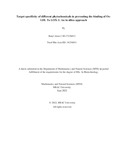Target specificity of different phytochemicals in preventing the binding of OxLDL To LOX-1: An in silico approach
Abstract
With an estimated 17.9 million deaths each year, cardiovascular disease (CVD), particularly
myocardial infarction (MI), is the leading cause of death globally. Most MIs are caused by thrombi
that form over ruptured atherosclerotic plaques obstructing coronary arteries. Despite the
outstanding benefits of lipid-lowering medications, 50% to 70% of patients who achieve their lipid lowering targets still have a high CVD risk. LOX-1 (lectin-type oxLDL [oxidized lowdensity
lipoprotein] receptor 1), a membrane receptor of oxLDL, has lately emerged as a viable target for
CVD treatments. Various studies suggest that LOX-1 is involved in all the main steps in the
pathogenesis of atherosclerosis. The aim of this research is to study the target specificity of various
phytochemicals for the LOX-1 receptor and to assess their therapeutic potentialities depending on
the stability of ligand-protein complexes. This study utilizes various tools and software to carry
out pharmacokinetic analysis, molecular docking and molecular dynamics simulation to determine
the drug likeness of the ligands, the strength of the binding affinity, hydrogen bonding and
hydrophobic interactions and the various measures of dynamics simulation to predict the stability
of the complexes. Among the initial 40 compounds chosen, 10 best compounds were picked based
upon their drug-likeness, toxicity, absorption and clearance. Upon conducting the molecular
docking simulation for these compounds alongside the statins, it was derived that the compounds
generally showed a higher binding affinity compared to the statins. Upon completing the molecular
dynamic simulation (MDS) for these complexes, it was derived that most of the compounds chosen
showed promising results in terms of binding versatility and free binding energy.

